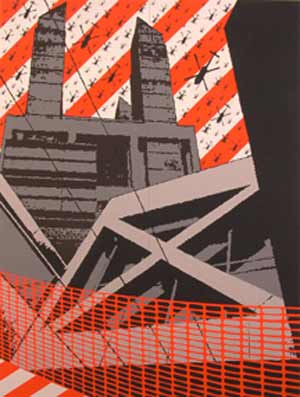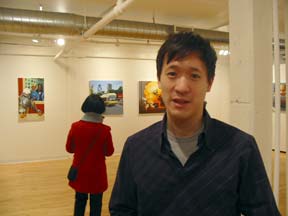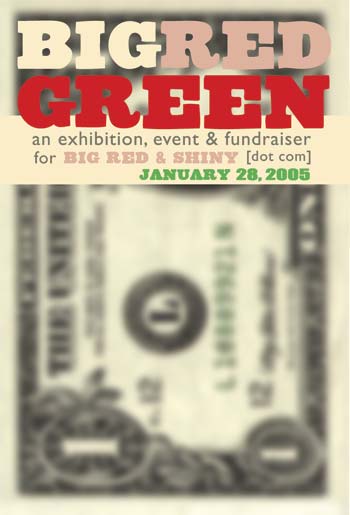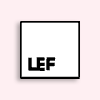“No cornering or stampeding,” founder and curator James Hull says smiling warmly at people closing in on both entrances of America’s only subway gallery. “5-4-3-2-1,” he shouts, and the crowd funnels in greedily grabbing red-hot tags marking their favorite of the 150 artworks for $150. In seconds, Emil Corsillo’s painting “Caution” is snatched up, and the young artist appears, surveying the crowd for the buyer of his work.
The 150 x $150 Mad Dash fundraiser was a prelude to Corsillo’s solo debut—an abstract painting and print exhibition that will be featured at the Green Street Gallery from December 3–January 29. As a part of his MFA thesis seminar at Boston University with instructor James Hull in 2003, Corsillo made a painting titled “Code Orange” that inspired the current direction of his work—abstract political metaphors that draw on Boston’s industrial iconography, like the architecture of the Big Dig.
Extending the visual themes of “Code Orange” — a response to Bush Administration policies on the war in Iraq represented by collapsing steel structures and cautionary stripes of orange—Corsillo’s new paintings explore Orwellian “Big Brother” themes through a language of hazard and industrial symbols.
In “Ministry of Peace,” a looming, bleak tower is fashioned after a Big Dig exhaust structure; the sky’s diagonal orange and white stripes hold a swarm of helicopters falling into lines like an army of ants. The feeling of controlled chaos is heightened by a collapsed structure and some orange construction netting that sections off the foreground.
Hunched over in a baseball hat and jeans, Corsillo says his images emanate from both his political convictions and from images he sees walking around Boston. “It’s serendipitous, the way things happen,” he says, describing how his painting “Free Speech Zone” came about. In the habit of photographing Boston’s industrial forms, Corsillo snapped a picture under the now demolished elevated roadway near North Station. Days later, he spotted an identical photo on the cover of the Boston Globe marking the protest that occurred during the Democratic National Convention. “It’s like when you learn a new word and you read it in a book the next day,” he says of his process, “it’s very back and forth.”
While the symbolism is similar throughout Corsillo’s paintings and prints, each explores a different slice of social or political commentary. The heavy, intertwined Jersey barriers in “O’er the Ramparts,” for example, were inspired by the protective barricade surrounding Boston’s Federal Reserve Bank building, a potential terrorist target. Considering the vulnerability of the people working inside that building, Corsillo’s mind skipped to the Star Spangled Banner: “Whose broad stripes and bright stars, through the perilous fight; O’er the ramparts we watched…”
Realizing the song was about war behind the safety of a barricade, Corsillo’s painting “O’er the Ramparts” became the subject of “the division between the battleground and the safe-zone, between just and unjust war, between two sides fighting each other…and what it might be like to be on the other side.”
“Heat Wave 2054,” by contrast, is an apocalyptic glimpse of global warming. Originally featured as a part of the show “Virtual Democracy “ at the Fort Point Arts Community (FPAC) Gallery, the painting is a hot-colored maze of metal interfaces that represent, as Corsillo puts it, “an unrecognizable, burning wasteland.”
In an urge to break free of the linear world of painting his own ideas, Corsillo created the collaborative “Water Hammer” with artist and studio mate Nick Higbee. Together, the two attracted local press attention with a performance art video called “Blowing Shit Up” that showed the two blowing up strawberries, oranges, Cadbury eggs and milk cartons—ultimately devolving into ominous growling ala “Lord of the Flies.” Meant as a “comedic metaphor of masculine violence,” the local news cast the work simplistically as a frat boy stunt, whereas the Green Street Gallery ran it successfully as a part of its Cyber Lounge video show.
For James Hull’s latest gallery, Aardvark, Corsillo collaborated with other artists on a performance installation piece for the gallery’s curatorial lab. A time-lapse video documents the “Tape Off”—a twelve-hour day in which two teams of artists work on opposing walls to create vivid images with multi-colored tape and paint. Other joint exhibitions that showcased Corsillo’s work include the Green Street Gallery’s war-themed show, “Superpower,” the “Digital Visions” exhibit at the Sacramento Center for Contemporary Art, as well as a few 150 x $150 fundraisers.
Green Street Gallery curator Hull—who has launched the careers of four Institute of Contemporary Art (ICA) award-winning artists—praises Corsillo’s “guts to show how our social landscape has changed without getting too preachy or depressing.” Discussing the power and cohesion of Corsillo’s compositions, Hull says, “I have a piece of Emil’s artwork in my home and it outshines the work of much more famous artists.”
Corsillo—who never envisioned a career as an artist while studying physics and philosophy as an undergrad at the University of Pennsylvania—says he tries to look at his work with eyes wide open, as someone walking through the door of a gallery would. He thinks carefully about the titles for his works so as not to be “overly literal (like if he were to name a painting “Fuck Bush”), or so esoteric or vague as to be an excuse.” In developing his work, Corsillo sometimes struggles translating images onto 80” by 90” wooden boards—an elaborate process in which photographs turned computer images are projected onto his canvas. “Sometimes what looks powerful on the computer screen looks empty and weak when the image is projected,” he says.
Excited and admittedly nervous about his first solo show, Corsillo is now entirely focused on the success of this exhibition, but is also contemplating the next step in his career. Still buzzed by his recent collaborative experience, he suggests that his next venture may be born out of brainstorms with Water Hammer’s Higbee.
If Bruce Springsteen and Susan Sarandon can sing and spew volubly about the anti-Bush imperative, Corsillo can make it dance visually in the powerful language he invented to sound the alarm. Through his accessible iconography and captivating forms, Corsillo’s exhibition will give the Green Street Gallery’s broad audience a perspective with grit and integrity that is worth a look.
Links:
Green Street Gallery
"Emil Corsillo: Free Speech Zone" is on view December 23, 2004 - January 29, 2005 at the Green Street Gallery.
All images are courtesy of the artist and the Green Street Gallery.
Lisa Mitchell is a writer who recently deserted corporate America for the shores of Cape Cod to write things like this to her heart's content. She is a new contributor to Big, Red & Shiny.




